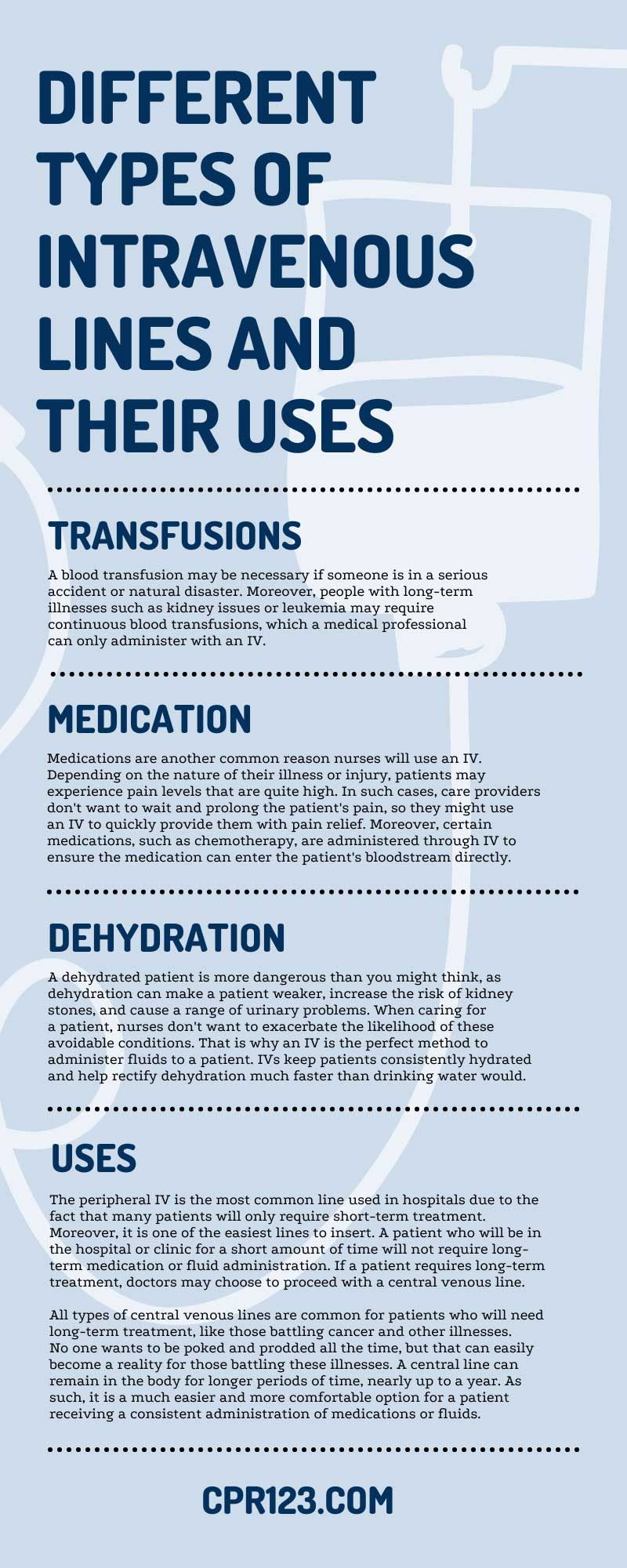No matter your role in the healthcare field, you can make a pivotal and significant contribution to society by helping many patients throughout your career. Your abilities and success in caring for others will rely heavily on the skills and education you acquire during your training. That is why it can feel so stressful to face the weeks, months, and years of diligent and consistent education required for individuals in the healthcare industry. You want to ensure you receive the best knowledge, as it will serve you for years to come.
Intravenous Lines
If you were to look into the future of your role in the healthcare field, you would see one common theme across multiple disciplines—intravenous lines. You might be somewhat familiar with intravenous lines but might not know how to administer one. That is why we have prepared this guide on the different types of intravenous lines and their uses.
What Is an IV?
An intravenous line (IV) is the main way nurses administer a variety of medications or fluids directly into the bloodstream of a patient. IV is the most common method of medication or fluid administration, as the liquid immediately enters the patient’s body, helping aid their recovery as quickly as possible. There are several reasons to use an IV with a patient.
Transfusions
You may have visited a local blood bank to donate your blood for a better cause. Every day, thousands of people become patients in clinics or hospitals and require a blood transfusion to better their chances of survival. A blood transfusion may be necessary if someone is in a serious accident or natural disaster. Moreover, people with long-term illnesses such as kidney issues or leukemia may require continuous blood transfusions, which a medical professional can only administer with an IV.
Medication
Medications are another common reason nurses will use an IV. Depending on the nature of their illness or injury, patients may experience pain levels that are quite high. In such cases, care providers don’t want to wait and prolong the patient’s pain, so they might use an IV to quickly provide them with pain relief. Moreover, certain medications, such as chemotherapy, are administered through IV to ensure the medication can enter the patient’s bloodstream directly.
Dehydration
A dehydrated patient is more dangerous than you might think, as dehydration can make a patient weaker, increase the risk of kidney stones, and cause a range of urinary problems. When caring for a patient, nurses don’t want to exacerbate the likelihood of these avoidable conditions. That is why an IV is the perfect method to administer fluids to a patient. IVs keep patients consistently hydrated and help rectify dehydration much faster than drinking water would.
Whose Line Is It Anyway?
Now that you know the main reasons a healthcare practitioner will use an IV on their patient, you might also be wondering about the methods of administration. There are several different types of intravenous lines, and their uses vary depending on the medical situation. Knowing the most common IVs will help you become better prepared to start one in the future.
Peripheral IV
You may have had a peripheral IV inserted into your hand or arm if you have ever been in the hospital or had your blood drawn. This peripheral, or what many also call a regular IV, is the most common line used to administer fluids or medications to a patient. The peripheral IV line inserts a soft, short, and small plastic tube into a patient’s arm or hand. Due to its small size and placement, this IV is not suitable for long-term use or higher volumes of medication.
Uses
The peripheral IV is the most common line used in hospitals due to the fact that many patients will only require short-term treatment. Moreover, it is one of the easiest lines to insert. A patient who will be in the hospital or clinic for a short amount of time will not require long-term medication or fluid administration. If a patient requires long-term treatment, doctors may choose to proceed with a central venous line.
Insertion
A large portion of a healthcare practitioner’s role involves peripheral IV insertion. Though the idea of inserting a peripheral IV into a patient’s body might seem terrifying, you shouldn’t worry too much, as the process is incredibly easy to learn. At CPR123, we are passionate about providing you with the knowledge you need to succeed in the medical field.
That is why we provide IV certification in Texas and New York. Through our courses, you will learn from experienced instructors about insertion techniques, care, assessment, and maintenance of a peripheral intravenous catheter. When you choose CPR123, you can rest assured that you are receiving the most in-depth education you can find.
Central Venous Line
A central venous line or central venous catheter is an IV that a practitioner inserts into one of a patient’s large central veins. A central venous line will most commonly go directly through the femoral, internal jugular, or subclavian vein. Due to the fact that this catheter enters directly into the main arteries, only doctors, radiologists, and specially trained nurses or technologists may insert a central venous line.
PICC
A peripherally inserted central catheter (PICC) is a type of central venous line; the main distinction is the place of insertion. A central venous line enters directly into a large vein, while a PICC line does not.
A healthcare practitioner will begin the insertion of a PICC line by entering a vein in the arm, usually above the elbow. Once they find a suitable vein, they will carefully and slowly work the line into the vein, continuing until it enters a central vein in the heart. Due to the fact that the entryway to a central vein in the heart is not as direct as it is with a central venous line, the PICC catheter will be longer.
Uses
All types of central venous lines are common for patients who will need long-term treatment, like those battling cancer and other illnesses. No one wants to be poked and prodded all the time, but that can easily become a reality for those battling these illnesses. A central line can remain in the body for longer periods of time, nearly up to a year. As such, it is a much easier and more comfortable option for a patient receiving a consistent administration of medications or fluids.








